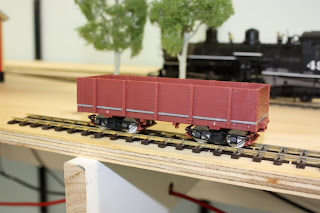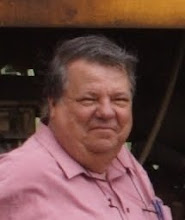We called in to our favourite model railway shop, Austral Model Craft as usual on Saturday morning (9/07). I took my hands out of my pockets for a change and bought two O Scale structure kits by a company called Big City Hobbies. One is a cemetery kit which includes twenty headstones, a mausoleum and fencing. The other is a fencing kit. Raymond bought two packs of Heki 20 cm pine trees. Each pack contains three trees. At $41.95 per pack, they are not cheap. Raymond also bought two boxes of Peco O-16.5 track (24 lengths).
Saturday afternoon we relaid one length of track in the depot loop to locate the track centres further apart. It appears we may have solved the problem of the K-36 and
K-37 locos touching on the end of the loop nearest the back wall of the shed.
Raymond test ran the K-37 and K-36 while we both carefully watched to see if we could determine the cause of the bogie trucks derailing. We concentrated on the K-37 running it backwards and forwards through the curved turnout. The outer track radius is 60 inches and the inner is 30 inches. I thought the problems may have been caused by the 30 inch radius of the points. The MMI On30 locos are supposed to be able to negotiate a 26 inch minimum radius and that is why we selected 36 inch radius for our main lines but even though the curved points were sharper they were still supposed to be 4 inches better than the minimum recommended radius. Was this a possible cause?
We watched the bogie trucks of the K-37 very carefully. One wheel of the rear truck would ride up on the outer rail and then the whole bogie would drop off the track even on plain curved track with 36 inch radius. What was causing this? Raymond inspected the loco on his work bench and discovered that the rear bogie truck’s metal frame was out of square. Every so often the wheelset would lock up in one of the axleboxes which would cause the bogie to lift onto the top of the rail head before allowing the bogie to drop off the track, Raymond trued up the bogie and it now appears that that bogie is tracking satisfactorily.
There are problems with the front truck on the K-37 too with one wheel lifting off the track at various times around curves and derailing. This problem is still being investigated and we have still to look at the K-36. We have also to check our other two K Class locomotives (K-36 and K-37) which are not yet fitted with decoders and so have not been run.
Sunday morning (10/07) we moved a cabinet which had been removed from the lounge/dining room upstairs into the shed. At this stage it is intended that this will only be temporary (about one or two years) as we will not really have any room for it when the last helix is put in. This cabinet is currently occupying a section of wall where that helix is to be installed. It is intended that this last helix will give us an option of continuous running but, as a general rule the layout will be operated as a point to point. This cabinet has a display case on top with glass doors and a cupboard underneath. I thought we could put some models on show in the display cabinet and use the cupboard for some additional much needed storage. Future storage may become available under the bottom deck of the layout when the lower level is built. I am hoping we can have low profile cabinets made on castors so they can be rolled out to allow access for maintenance under the layout when it is required.
Well, it turns out we didn’t manage to get the display cabinet into the shed. It was far too heavy with my wrist not being able to take the weight. They don’t call me Lefty for nothing.
I spent a pleasant Sunday afternoon running various locos backwards and for wards to try them out. We know we still have a problem with the K-36 and the K-37. Raymond is thinking through these issues. I tried Raymond’s K-28 No.470, It ran well so I don’t think we have any problems there. I also tried my C-19 2-8-0 No.345. It also ran well so I was happy with that.
 Mountain Model Imports (MMI) C-19 No.345 during testing on the layout.
Mountain Model Imports (MMI) C-19 No.345 during testing on the layout.
 MMI K-28 No.470 during its test on the layout
MMI K-28 No.470 during its test on the layout
 Bachmann 2-8-0 being tried out
Bachmann 2-8-0 being tried outI then sat down at my work bench and started the second of two Porter tenders I had been making from a Boulder Valley Models kit. I had a couple of Kadee No.5 couplers already made up salvaged from one of my old New South Wales wagon kits (choke, cough, splutter). Wash your mouth out boy – we don’t talk about that funny New South Welshmen type rolling stock items here. They can’t even win a State of Origin series. Standard gauge – eeewwww!!! Once, I got over the shock of having to handle an old SRC wagon from my scrap box to salvage the couplings I did some modifications to the couplings and then fitted them to the tender deck. The remnants of the SRC went into the rubbish tip to become land fill. I then fitted a Steam Era Victorian Railways diamond frame bogie to the deck of the Porter tender. Now all I have to do is fit the superstructure and detail it.
Raymond spent a pleasant Sunday afternoon building his Foothill Model Works coal gondola. He had purchased some fine twist drills and a suitable pin vice (none of ours would hold these fine drill bits). He completed the bogies and has started on the body of this finely detailed model.
 One of two bogies Raymond made for his Foothill Model Works coal gondola
One of two bogies Raymond made for his Foothill Model Works coal gondola A view across the goods yard with a row of MMI locos on the left-hand track - a K-37; K-36; C-19 and a K-28. They made an impressive line up.
A view across the goods yard with a row of MMI locos on the left-hand track - a K-37; K-36; C-19 and a K-28. They made an impressive line up.


















